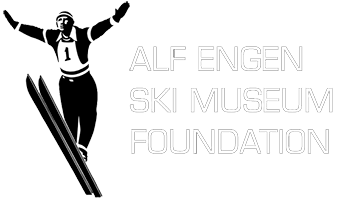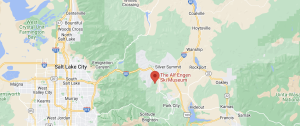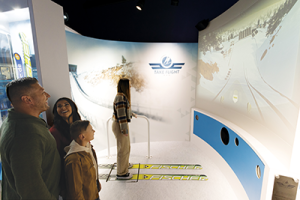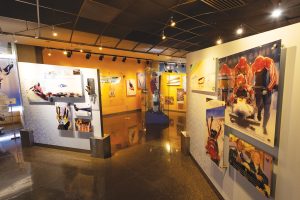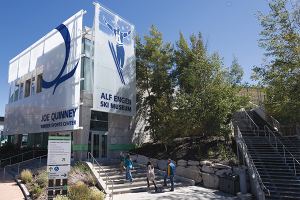Q: What is the history of the Alf Engen Ski Museum?
A: The idea of a ski museum originated in 1989 when a group of enthusiasts led by Alan Engen recognized the need to honor the pioneers and athletes who had significantly contributed to winter sports in the Intermountain Region. Initially envisioned as a small A-frame structure to house Alf Engen’s collection, the museum grew into a 29,000 square foot facility thanks to generous donations. Its location was chosen for its proximity to Ecker Hill and the 2002 Olympic Winter Games venues. The groundbreaking for the Joe Quinney Winter Sports Center took place in 2000, and the building served as a media center during the 2002 Winter Games. The museum then moved into the Sports Center and opened to the public in 2002. The George Eccles Salt Lake 2002 Olympic Winter Games Museum opened in 2005.
Q: Was Alf a part of the 2002 Olympic Winter Games in Utah? What were his feelings about Utah hosting the games?
A: No, Alf passed in July 1997. However, he did play an active part in the bid process and was a member of the Site Selection Committee that chose the location for what is now Utah Olympic Park. The Salt Lake Olympic Bid Committee for the 2002 Winter Games made a special card featuring Alf and his accomplishments that was sent out worldwide. One of these cards can be found at the University of Utah Marriott Library Ski Archives in the Alan Engen Ski History Scrapbooks.
Q: Where is Alf Engen buried?
A: Alf is buried in the city cemetery at Centerville, Utah.
Q: What was the first resort in Utah to install and use mechanized lifts?
A: It it is assumed that the term “resort” refers to winter skiing accommodations for locals and out-of-state visitors. In this context, Alta was the first to provide uphill chair lift conveyance along with public shelter accommodations. The original Collins Lift at Alta began operation to the public in January 1939. The ski area itself opened in 1938. The first three ski areas to construct chair lifts in Utah were:
- Alta – Started chair lift operation to the public during 1938-39 ski season
- Snowbasin – Started chair lift operation to the public during 1945-46 season
- Brighton – Started chair lift operation during the 1947-48 ski seaon
It should be noted that Brighton, Alta, Snow Park (now Deer Valley), Beaver Mountain in Logan, and Timp Haven (now Sundance Resort) had other tow devices in operation at their respective locations prior to chairlifts being constructed.
Q: Did Utah have the first chairlift in the nation?
A: No. Alta was the first ski area in Utah to install a chairlift but not the first in the nation. Alta’s lift was installed in 1938 and was operational in January 1939. This actually was the fifth chairlift in the United States, following the three lifts installed in Sun Valley, Idaho and one chairlift in Laconia, New Hampshire.
Q: Who were the first contributors whom Joe Quinney convinced to finance the new Alta ski area in 1937?
A: Alta, as a ski area, began with the construction of the original Collins chairlift. Following a 700-acre U.S. Forest Service land acquisition donated by miner/prospector George H. Watson in 1937, a group of businessmen, led by S. Joe Quinney, formed the Salt Lake Winter Sports Association (WSA). They raised $10,000 to build the first ski lift at Alta, Utah. In addition to Quinney, that visionary group of men included: W.J. O’Connor, V.R. Parkinson, L.R. Ure, Paul F. Keyser, E. Bartlett Wicks, Stewart Cosgriff, and P.H. Kittle.
In 1938, the WSA made an agreement with the Michigan-Utah Mines to purchase the aerial tramway which carried ore from Alta, down Little Cottonwood Canyon, to Tanner’s Flat during the early 1900s. Michigan-Utah Mines president Bill O’Connor (who was also an original member of the WSA group) agreed to be in charge of designing and building the chairs for the proposed chairlift which was planned to go up Collins Gulch, named after Charles Collins, an early Alta miner. The funds raised by the WSA were sufficient to construct the wooden towers, cables, and chairs and allowed the original Collins Lift to officially open to the public in mid-January 1939. Skiers were initially charged 25 cents per ride or $1.50 for a day pass. The original Collins Lift was the first uphill chairlift conveyance in Utah and the fifth built in the United States.
Q: Where were the first ski lodges in the area?
A: The Snowpine was the first lodge in Little Cottonwood Canyon. Built in 1938, it was initially called the Rock Shelter. Its original purpose was as a warming shelter for day skiers. The Alta Lodge was constructed in late summer of 1940; the Rustler opened on Thanksgiving Day 1947; and the Peruvian Lodge opened in 1948.
The Rustler Lodge was initially started by Howard Stillwell. Stillwell’s father was an early Alta mining pioneer and owned the land which was passed on to Howard. Howard opened the partially completed lodge in November 1947. In early 1948, Sverre Engen took a financial interest in the Rustler Lodge as a partner with Howard and helped finish the initial construction. In addition, Sverre and his wife Lois were the first managers of the lodge operation and ran it for several years.
Both Alf and Sverre Engen emigrated to the United States in 1929. Alf came first, arriving in July, and Sverre followed later in the fall of that year. Alf first entered Alta in 1935 when he was hired by the Forest Service to select areas conducive to ski development. However, he did not work at Alta until 1948, after coaching the U.S. Olympic Ski Team in the 1948 Olympic Winter Games. Sverre began his career at Alta in the late ’30s or early ’40s when he was hired by the Forest Service to be the first snow ranger. In 1945, Sverre became the seventh Alta Ski School director. Alf took over the ski school from Sverre in 1948. More details about all the ski school directors can be found in the Spring 2009 edition of the Alta Powder News at www.altahistory.org.
The first chef at the Rustler Lodge was Finn Gurholt, a Norwegian who emigrated to the United States in the early 1950s. Finn became a well-known chef in the Salt Lake area, eventually creating a highly respected restaurant called “Finn’s.” He died in 1991 at the age of 70.
The owners of the five Alta Lodges in 1970 were Bill Levitt (Alta Lodge), Lee Bronson (Rustler Lodge), Edwin Gibbs (Peruvian Lodge, sold to John Cahill in late 1970), Jim & Elfrieda Shane (Goldminer’s Daughter), and Al Kapp (Snowpine Lodge).
Q: It is well-known that the miners and Mormon pioneers devastated the forests along the Wasatch Front. Is it true that Boy Scouts were responsible for replanting the trees more than 100 years ago?
A: Conservation efforts provided by Boy Scout tree planting activities probably did play a contributing role over the years and their efforts need to be applauded. However, in terms of significant impact to reforestation in the Wasatch mountains, the signing of Executive Order 6106 in 1933 by President Franklin D. Roosevelt, creating the Civilian Conservation Corps (CCC), started a program which had a more profound impact on Utah over the following decade. CCC workers performed hundreds of jobs in Utah, working on roads and perhaps most important, forest replantation projects in the Cottonwood Canyons. A major CCC camp was located at the mouth of Big Cottonwood Canyon which accommodated approximately 200 personnel. Alf Engen was a CCC foreman at that camp in the mid- to late 1930s. There is little question that the CCC tree planting at Alta had a significant positive effect on the area’s development as a ski resort.
